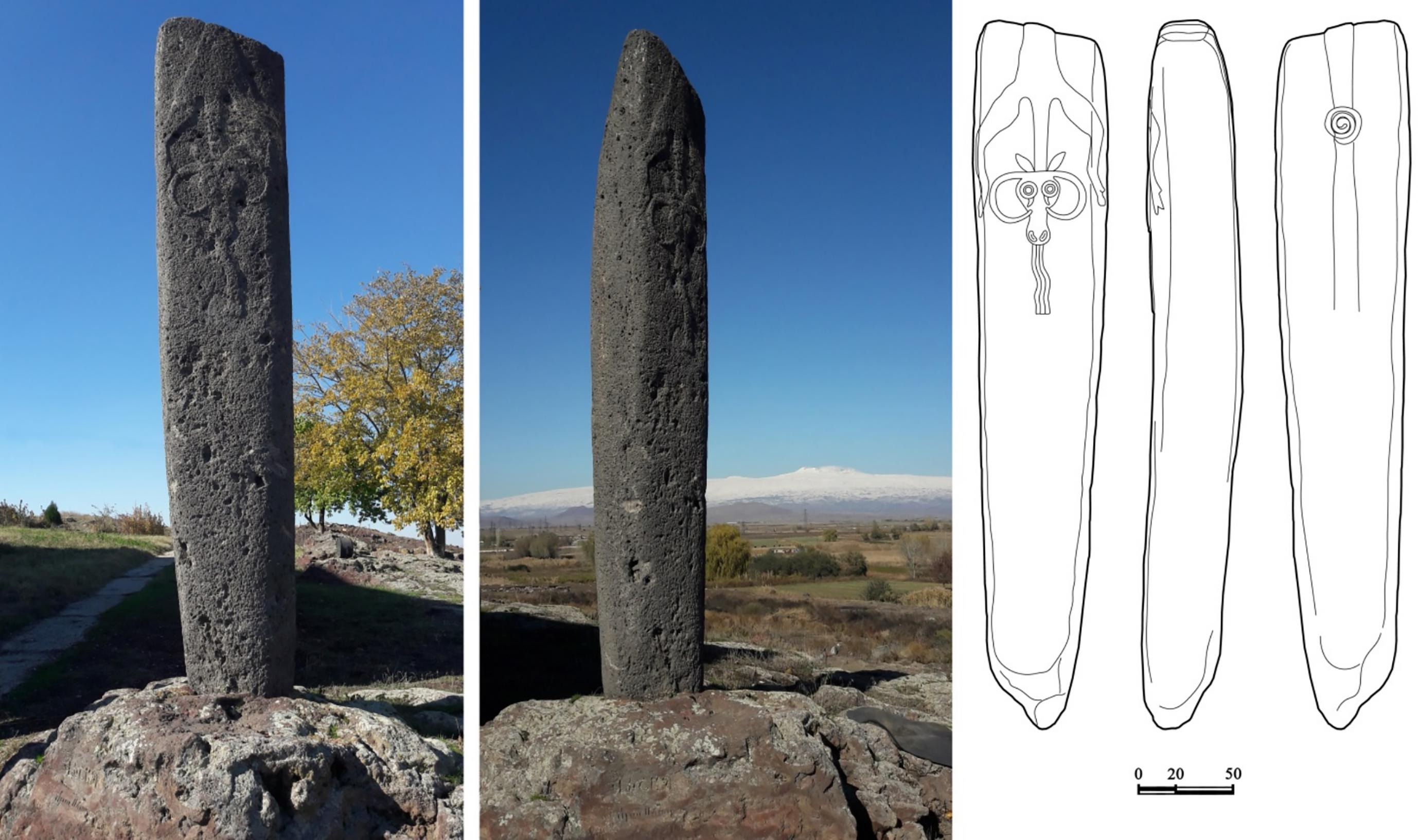During the 16th century BCE, prehistoric people in what is now Armenia placed a 3.5-meter (9.8-foot) tall basalt stone over a barrow. Buried below the stone were the remains of an adult woman and two newborn children. At first, researchers believed the babies were twins, but new analysis suggests a more complicated and remarkable relationship.
So called “dragon stones” are stelae – upright stone slabs or columns – that depict animal imagery. They are typically found in the mountains of present-day Armenia and the neighbouring regions of southern Georgia and Eastern Turkey.
It is thought the stones are named after local folk stories concerning dragons that take the form of bulls, fish, or snakes in the mountains, which serve as guardians of water and thunder.
To date, around 150 dragon stones have been discovered. Typically, they are found collapsed and hidden in secluded areas where there is plenty of water, like mountain meadows. There are thought to be three types of dragon stone, as identified by archaeologists: those with fish-shaped carvings (piscis); those that look like the remains of bovids, like goats, sheep, cows and so on (vellus); or a mix of the two (hybrid).
The dragon stone with the two babies buried below it is an example of the vellus style. It shows the hide of a bovid flopped over the top of the stone. “The hide”, as the researchers explain in their paper, “descends from the top of the stone to the back, ending in a tail with a multi-spiral bundle.”
“The bovid’s ears and the horns with arches descending on either side of the head are clearly distinguishable. A liquid flowing from the mouth of the bovid may represent water, blood, or a synecdoche of both.”

The dragon stone at the burial site, with a line drawing by A. Hakhverdyan showing the depiction of the bovine animal that allows it to be classified as the vellus style.
The stone was discovered in 1980 in an ancient cemetery called Hamaliri taratsk close to the village of Lchashen, in a plateau near Lake Sevan, Armenia. This whole area has previously yielded valuable archaeological information regarding the lives of Bronze and Iron Age peoples living in South Caucasus.
After some initial examination of the stone in situ, it and other materials excavated from the burial site, were transported to the Metsamor Historical-Archaeological Museum Reserve.
The barrow chamber was buried about 2.5 meters (8.2 feet) below the surface and had a pebble filling. It contained broken pottery and other artifacts, animal bones, and the remains of a human skeleton (believed to be that of an adult woman).
Unfortunately, the woman’s bones are now missing. They were apparently sent to Russia in the 1980s for further analysis and have not been located since then. But the bones of the two infants – referred to as Dragon1 and Dragon2 – remain. In fact, they were not even detailed in the original publications regarding this barrow.
Anthropological analysis confirmed that the remains of Dragon1 and Dragon2 belonged to children between 0 and 2 months of age. Radiocarbon dating has confirmed that they both died sometime between 1616-1503 BCE.
However, this analysis alone cannot determine whether the babies died and were buried together at the same time. It is possible they may have been born at separate points in this time range and were placed in the same grave, years or decades apart. But the researchers believe this is unlikely.
This is because, from an archaeological perspective, the burial site does not appear to be a multigenerational tomb. As they explain, “multigenerational tombs are not attested among the over 400 tombs excavated at Late Bronze Age Lchashen, nor are they in any other contemporary necropolis in Armenia.”
If they are correct, then the two babies were likely buried together. The genomic evidence indicates that they were second-degree relations, sharing around 25 percent of DNA. This is a strange puzzle.
“Biologically speaking”, the authors write, “this may result from the two individuals being (a) half-sisters, (b) aunt (likely maternal) and niece, (c) double-cousins or (d) grandmother (likely maternal) and granddaughter.”
Given that barrow is not likely a multigenerational tomb, we can eliminate several of these possibilities. It is not likely that the infants belong to a grandmother and a grandchild, of course, nor is it likely that the individuals were aunt and niece. This scenario would require one parent and their offspring to each have a daughter and to lose them at the same time.
This then suggests that the babies may have been half-sisters (based on mitochondrial analysis and other information). If so, then this is a rare example of heteropaternal superfecundation, the situation where a mother carries twins from different fathers. However, the exact relationship between the pair cannot be determined from the DNA data alone.
If the adult skeleton were still available for analysis, it may be possible to shine greater light on their relationship, but that is not currently an option.
Nevertheless, the mystery is significant. As the researchers explain:
“The event envisaged by the burial is in any case exceptional, both from the point of view of genetics and from the archaeological viewpoint. In Late Bronze Age Armenia in general and at Lchashen in particular, burials of children are rare and the burial of two newborns combined with a monumental stela is unique.”
Ultimately, they argue, the exceptional nature of the individuals buried at this site may well explain why they were placed under a monument as important as a dragon stone.
The study is published in the Journal of Archaeological Science: Reports.
Source Link: Prehistoric Babies Buried Beneath “Dragon Stone” May Have Had Exceptional Birth